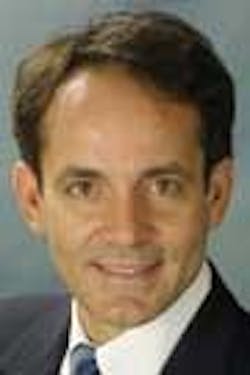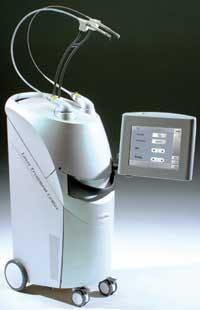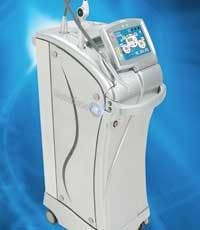The long, winding road
One dentist explains the series of events that convinced him to purchase a laser
By Donato Napoletano, DMD
The thought of tooth preparation and caries removal without anesthesia has always intrigued me. Air abrasion is one of the first technologies allowing dentists the opportunity to accomplish this.
In the mid-1990s, one of the air abrasion companies offered me an opportunity to try the unit out in my office for one day on my patients. Although they claimed I would be able to prep teeth without anesthetic, I was surprised to find that I still had to anesthetize every patient. In addition, I found that, although it removed enamel fairly efficiently, it was less efficient in removing caries. Finally, by the end of each procedure, the operatory looked like a bakery shop and the patients looked like they dove face-first into a box of powdered donuts.
The representative of the company stated that all of the above problems were most likely due to operator inexperience. Seeing as there are successful and satisfied users of this technology out there, she was most likely right about this, but I really did not like the mess it left in my office. So I sent her and the unit on their merry way.
In 1997, the erbium lasers received FDA approval for hard-tissue procedures. Like air abrasion, lasers were also being marketed as being able to perform cavity preparations without the use of anesthesia. I assumed that, like air abrasion, most likely only very experienced users were able to accomplish this and never bothered to research it further. What I was experiencing was a form of denial which inhibited me from believing that any form of technology would ever eliminate the need to anesthetize a patient. This denial would prevent me from taking a serious look at lasers for many years.
My first experience with lasers (enlightenment)
Oddly enough, my first experience with lasers did not involve a dental laser at all; it involved Lasik eye surgery.
In October of 2003, Donna, a long-time patient of mine, was in for her check-up. During her visit, we were talking about how much we hated wearing eyeglasses and contacts and how great it would be to finally be rid of them with laser eye surgery. We both knew many people who had had this procedure, but the thought of something going wrong prevented us from picking up the phone and making that first appointment.
We continued to discuss what a shame it was that we could not get up the courage to take that first step. I then asked her if we could go for a consultation visit together. At first, she thought I was joking, but I reassured her that, if she called to make a consultation appointment for her, she could also make one for me. I knew that I would never do this on my own and figured that she probably wouldn’t do it either.
Donna returned to my office toward the end of October to have a filling done. She handed me some papers and said that our consultation appointment was set for Nov. 1 and, if we desired, we could also have the procedure done on the same day. I remember feeling both nervous and excited at the same time.
When Nov. 1 came along, Donna, I, and our spouses went for our consultation visit. Before we knew it, our eyes were prepped up and ready to be zapped. In two minutes, it was all over. Within hours, I could see better than I did with my contacts. This was simply amazing and I could not believe that I waited so long to do this. Thank you, Donna, and thank you, Dr. Dello Russo! This experience turned out to be a very enlightening experience and was the catalyst that sparked me to find out more about dental lasers.
Laser experience #2 (discovery)
Immediately following my eye surgery, I could not help but wonder if the use of a dental laser would have such a positive impact on my own patients. Since I personally do not fear oral injections, having a tooth filled without anesthesia would not rate very high for me compared to my eye surgery, but what impact would this have on a patient who is deathly afraid of needles? Well, the answer was obvious to me, but I really wanted to know if a cavity preparation could in fact be performed without the use of anesthetic.
Thanks to the Internet, I soon learned from reading numerous clinical studies and thousands of posts made by laser dentists around the world in laser dentistry forums that removal of decay without anesthetic was in fact possible with lasers in a high percentage of cases. I was also impressed by the fact that some of these users were dentists who have had their lasers for only a few short months. I also learned (from studies, not from marketing) that many soft-tissue procedures such as fibroma removals and lingual frenectomies could also be performed with the erbiums with decreased risk of postoperative infections, bleeding, and without the need for suturing.
Being severely tongue-tied myself, this became of particular interest to me. Unless you suffer from ankyloglossia, you have no idea what this is like. To get an idea of what it’s like, try this: push and hold the tip of your tongue against the lingual surfaces of your lower incisors and try to speak and/or eat while holding your tongue in that position.
My tongue-tie was so severe, that it would be chronically irritated from just normal eating. My tongue-tie is a much more annoying problem than my nearsightedness. However, since I have had this problem all my life, I’ve learned to live with it by avoiding certain foods and eating ice cream in a cup and not on a cone.
This problem is more significant in newborns where it can affect their ability to feed properly. In addition to speech problems, it can also interfere with normal orofacial development.
The more I read about lasers in dentistry, the more apparent the benefits of having one became. By this time, the next question was formulating in my mind - which laser would be right for me?
The Greater New York Dental Meeting was coming up in a few weeks, so I had to get busy so that I could narrow down my choices.
Laser experience #3 (the acquisition)
The weeks of reading and researching until 2 a.m. had finally paid off. I already had an idea of which manufacturer’s unit I was going to acquire by the time the 2003 Greater New York Dental Meeting arrived.
I personally could not find any studies that showed one erbium to be more effective than another in cutting or ablating tooth structure, so the criteria I used in choosing my laser were:
- Financial stability of the company
- Ease of portability and unit width
- Handpiece that did not resemble a dental drill.
- Adjustable repetition rates (Hertz) and energy (Millijoules)
The unit that I chose which met all of the above criteria to my own personal satisfaction was the HOYA Con Bio DELight Erbium:YAG laser.
Before I knew it, the acquisition was made and found myself getting that nervous and exciting feeling again as I signed on the dotted line.
Laser experience # 4 (my first month)
Soon after the new year arrived, so did my laser. A representative from the company came to uncrate and prepare the laser for operation. He thoroughly went over some safety precautions and also went over some general operating guidelines that I found fairly easy to learn and understand. Unlike the air-abrasion rep, he seemed fairly confident that I would be able to do procedures without anesthesia right from the start.
The next day, I lased my first patient without local anesthetic. We were both impressed and I was excited and relieved! The hardest thing for me the first few days of operation was telling myself I was not using a side cutting rotary instrument. As most of you know, lasers are end cutting only. Therefore, you cannot just sweep across a preparation like a drill. I did not find the learning curve long at all. By the end of January 2004, I completed 55 cavity preparations on 24 patients - all without anesthetic. Only four of the patients complained of moderate sensitivity and only one patient (a teenager) stated that he would prefer to receive a local anesthetic on future visits.
Although certification is not a requirement for using an erbium laser, I wanted to learn as much as possible about the laser I was using, so I attended the Hoya Con Bio College of Clinical Laser Dentistry at the Las Vegas Institute of Advanced Dental Studies. We learned about many types of lasers and the physics behind them. We also saw live demonstrations of various other procedures such as gingivectomies, aphthous ulcer treatments, cavity preparations, and lingual frenectomies. At the completion of the course, attendees were given the option to participate in a written and practical examination in order to receive standard proficiency certification from the Academy of Laser Dentistry.
Laser experience #5 (my tongue - the final frontier)
On the first day of the course, the instructors asked if there were any attendees who needed to have a cavity preparation, aphthous ulcer treatment, gingivectomy, or frenectomy done. They found volunteers for the first three procedures mentioned. I considered volunteering my tongue, but having a procedure done live in front of 100 or so spectators didn’t appeal to me.
The next day, just before a lecture to be given by pedodontist Dr. Lawrence Kotlow, they made a last call for any other volunteers. The more I thought about this and the sequence of events that brought me there in the first place, the more I realized that my lingual frenectomy was meant to be.
At the end of the lecture, I showed Dr. Kotlow my tongue. In less than a minute, I found myself in the front of the auditorium with my colleagues seemingly salivating over my tongue. There was definitely no turning back now and before I knew it, another one of those nervous and excited feelings started to set in.
Since Dr. Kotlow stated that he had done more than 400 lingual frenectomies, I wasn’t nervous about the procedure. The only thing that worried me was how much pain I was going to be in later and if it was going to affect my taking the proficiency examination the next day. Also, the company was having a dinner that evening for all the students and there was going to be entertainment by an Elvis impersonator. I did not want to miss that!
Dr. Kotlow assured me that all would be fine and, before I knew it, I was anesthetized and ready for surgery. Amazingly, the procedure took less than 30 seconds, no sutures were used, and there was no postoperative bleeding whatsoever. I did have some pain after the anesthetic wore off, but nothing that a few ibuprofen could not handle.
Amazingly, I was even able to eat dinner that night. It felt strange eating with my newly freed-up tongue and I even felt that I could taste my food better now. Again, I wondered why I had waited so long to do this. Thank you, Dr. Kotlow!
As I sat at the dinner table watching the Elvis impersonator, I could not help but wonder if his act would improve if he teamed up with a Gene Simmons impersonator. Hey, I may be onto something big here! Just think about how many prospective Gene Simmons impersonators would need lingual frenectomies if that idea ever took off.
Figuratively speaking, I almost feel like my lasered tongue can reach my lasered eyes! I continue to use my laser every day and have not regretted my decision one bit. The sequence of events over the last three months has proven to be one of the most exciting times of my professional career.
Editor’s Note: In the first 10 months he has owned a laser, Dr. Napoletano has completed more than 800 procedures, all without anesthesia.
Dr. Donato Napoletano owns Donato Dental in Middletown, N.Y., the first office in Orange County, N.Y., to use lasers and microscopes in the diagnosis and treatment of early stage cavities and gum disease. He has been in private practice since 1988. He can be reached by e-mail at [email protected] or by phone at (845) 342-6444.
Ivoclar Vivadent announces the Odyssey® Diode Laser, the most user-friendly, compact, portable, and affordable soft-tissue laser for dentistry to date. With a laser wavelength of 810+/-20 nm, the Odyssey® provides convenient settings for many procedures. Featuring the first-ever retractable fiber optic system and a simplified control panel, the Odyssey® Diode Laser satisfies clinicians’ long-standing need for an economical, quality-made laser that meets their esthetic and restorative demands. More detailed information can be found at www.GetOdysseyLaser.com.
The OpusDuo from OpusDent combines two lasers systems in one sophisticated unit. Its Er:YAG laser rapidly removes enamel and dentin while a new generation SuperPulse™ CO2 laser selectively vaporizes soft tissue. Switching from wavelength to wavelength is quick and effortless. The OpusDuo - touch screen monitor controlled - boasts 90 pre-programmed procedural presets. A proprietary “accelerator pedal” allows for hands-free frequency control, just like a drill. The result is a smooth, continuous, efficient and controlled workflow ensuring the finest patient care. For more information, contact OpusDent at (877) 586-3647 or www.opusdent.com.
The Waterlase MD all-tissue laser enables dentists to expand their clinical capabilities with dozens of anesthetic-free, FDA-cleared procedures related to cavity preps, soft-tissue sculpting, and cutting bone tissue. The new laser system incorporates dozens of user-requested features that helps new users as well as experienced laser dentists, including a rotating, contra-angle handpiece with LED illumination; on-board storage areas for accessories; a small, sleek chassis; a large, full-color, touch-screen for operating the laser, and many other important and unique features for use across all oral tissues. For more information, log on to www.waterlasemd.com.
The SoftLase 2.0Watt is perhaps the most versatile dental laser on the market. It is unsurpassed in user-friendly design and engineering. It is small, lightweight, and only occupies space equivalent to a box of gloves. The 2.0Watt delivers ample power for over 95 percent of all laser procedures. It’s embraced by practitioners worldwide for its dependability, low maintenance cost, and patient acceptance. It is also the most competitively priced dental laser on the market - and virtually sells itself! For more information, call (888) 876-4546 or log on to www.zaplasers.com.





